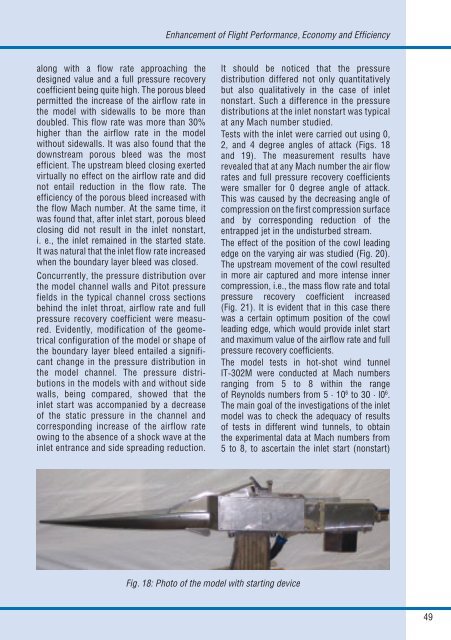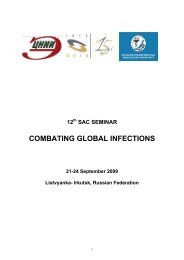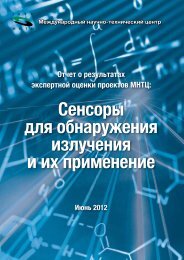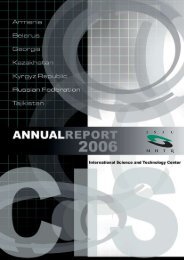Aerospace Research - ISTC Funded Projects 1994-2009
Aerospace Research - ISTC Funded Projects 1994-2009
Aerospace Research - ISTC Funded Projects 1994-2009
Create successful ePaper yourself
Turn your PDF publications into a flip-book with our unique Google optimized e-Paper software.
along with a flow rate approaching the<br />
designed value and a full pressure recovery<br />
coefficient being quite high. The porous bleed<br />
permitted the increase of the airflow rate in<br />
the model with sidewalls to be more than<br />
doubled. This flow rate was more than 30%<br />
higher than the airflow rate in the model<br />
without sidewalls. It was also found that the<br />
downstream porous bleed was the most<br />
efficient. The upstream bleed closing exerted<br />
virtually no effect on the airflow rate and did<br />
not entail reduction in the flow rate. The<br />
efficiency of the porous bleed increased with<br />
the flow Mach number. At the same time, it<br />
was found that, after inlet start, porous bleed<br />
closing did not result in the inlet nonstart,<br />
i. e., the inlet remained in the started state.<br />
It was natural that the inlet flow rate increased<br />
when the boundary layer bleed was closed.<br />
Concurrently, the pressure distribution over<br />
the model channel walls and Pitot pressure<br />
fields in the typical channel cross sections<br />
behind the inlet throat, airflow rate and full<br />
pressure recovery coefficient were measured.<br />
Evidently, modification of the geometrical<br />
configuration of the model or shape of<br />
the boundary layer bleed entailed a significant<br />
change in the pressure distribution in<br />
the model channel. The pressure distributions<br />
in the models with and without side<br />
walls, being compared, showed that the<br />
inlet start was accompanied by a decrease<br />
of the static pressure in the channel and<br />
corresponding increase of the airflow rate<br />
owing to the absence of a shock wave at the<br />
inlet entrance and side spreading reduction.<br />
Enhancement of Flight Performance, Economy and Efficiency<br />
Fig. 18: Photo of the model with starting device<br />
It should be noticed that the pressure<br />
distribution differed not only quantitatively<br />
but also qualitatively in the case of inlet<br />
nonstart. Such a difference in the pressure<br />
distributions at the inlet nonstart was typical<br />
at any Mach number studied.<br />
Tests with the inlet were carried out using 0,<br />
2, and 4 degree angles of attack (Figs. 18<br />
and 19). The measurement results have<br />
revealed that at any Mach number the air flow<br />
rates and full pressure recovery coefficients<br />
were smaller for 0 degree angle of attack.<br />
This was caused by the decreasing angle of<br />
compression on the first compression surface<br />
and by corresponding reduction of the<br />
entrapped jet in the undisturbed stream.<br />
The effect of the position of the cowl leading<br />
edge on the varying air was studied (Fig. 20).<br />
The upstream movement of the cowl resulted<br />
in more air captured and more intense inner<br />
compression, i.e., the mass flow rate and total<br />
pressure recovery coefficient increased<br />
(Fig. 21). It is evident that in this case there<br />
was a certain optimum position of the cowl<br />
leading edge, which would provide inlet start<br />
and maximum value of the airflow rate and full<br />
pressure recovery coefficients.<br />
The model tests in hotshot wind tunnel<br />
IT302M were conducted at Mach numbers<br />
ranging from 5 to 8 within the range<br />
of Reynolds numbers from 5 · 10 6 to 30 · l0 6 .<br />
The main goal of the investigations of the inlet<br />
model was to check the adequacy of results<br />
of tests in different wind tunnels, to obtain<br />
the experimental data at Mach numbers from<br />
5 to 8, to ascertain the inlet start (nonstart)<br />
49
















